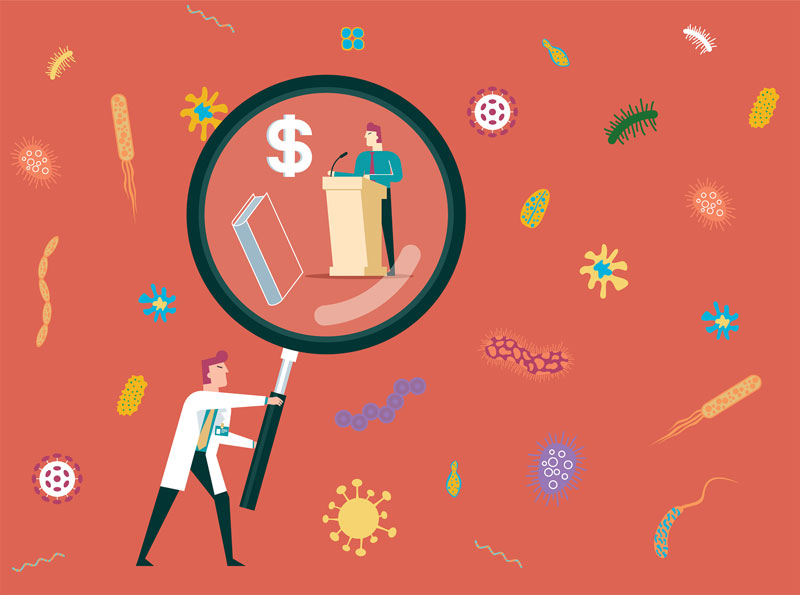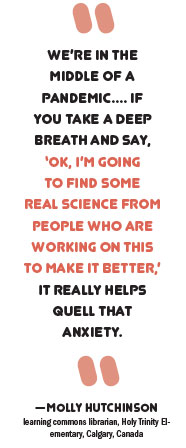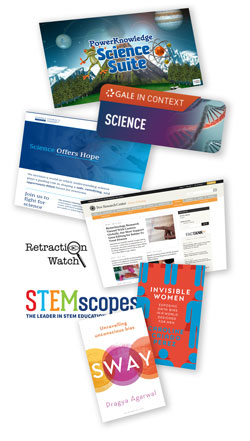Librarians Help Students Understand Biased Science
With science more prominent in the news, librarians are playing a greater role in science literacy and helping students learn how to flag biased and racist scientific research.
 |
SLJ montage source images: Getty Images/Sorbetto |
In 1932, 600 African American men in Alabama took part in a medical study on syphilis, a sexually transmitted disease caused by bacteria. U.S. Public Health Service researchers told the particpants—both with and without syphilis—that they were being treated for “bad blood,” a catch-all term for various ailments. But unbeknownst to them, some participants were denied any treatment at all.
The researchers’ true objective was to understand the long-term health effects of untreated syphilis. The Public Health Service continued to run the study even after 1947, when penicillin proved to be an effective treatment for syphilis. By the time the experiment ended in 1972 due to public outrage, 128 patients had died of syphilis or its complications.
The Tuskegee Study is an infamous case of racial bias in science. The mistreatment of marginalized communities is just one way that science and its results can be skewed, misleading, or corrupted, says Kathryn Houk, health literacy and community engagement librarian at the University of Nevada Las Vegas (UNLV). Scientific research can be subject to influence, springing from conscious or unconscious bias on the part of researchers or pressure from entities underwriting studies, among other factors. Currently, reporting on the pandemic, climate change, and social justice has revealed bias and misinformation in data interpretation. With science more prominent in the news, librarians—who are “experts on understanding information from inception to publication,” says Houk—are playing a greater role in science literacy and helping students learn how to flag biased scientific research.
The ramifications of bias can grow into deep-seated issues—contributing to poor science literacy and distrust in scientific information. The damage done by the Tuskegee Study, for instance, is still felt today. “This mistreatment has fed that lack of trust in science and medicine we see in the Black community in the U.S.,” says Houk, who curated books about the Tuskegee Study and other unethical science in her UNLV library research guide on racism in medicine and health care. “All of the ‘isms’ impact science—racism, sexism, classism.”
 Biased humans, biased data
Biased humans, biased data
Economic, political, racial, and societal pressures have swayed research all along. Facial recognition technologies, for example, have discriminated against people of color; sexism in medical trials has created a lack of understanding of women’s health; money and status have influenced what research is conducted and published.
“Researchers are, on the whole, curious people trying to solve problems, but they are human,” says Corey Powell, science journalist, contributing writer to Discover magazine, and cofounder of the Science Literacy Foundation, established in 2020. “You want to find a positive result, you want to keep your job, you want to be successful. All these human things that happen in every other kind of work happen in science, too.”
To better detect bias, it’s important to understand what scientists do and how the scientific process works, says Powell. Completing a study is a creative endeavor, much like writing a song or filming a movie, he notes. You might wonder why a movie director decided to capture a scene a certain way, or why a songwriter wrote a specific lyric. “When you see a scientific paper, you can think about it the same way,” he says. “Something very important motivated people to do this research. Who are these people? What are their possible motivations?”
A useful activity for students to try to unpack bias is to reverse-engineer a science news story—“pick apart an article paragraph by paragraph,” he says. Powell advises to ask your students: Who is quoted? Why is this person credible? How do you know the reporter is credible? What are the possible sources of bias?
Houk adds that information assessment needs to expand beyond previous questions and models of evaluation, like “the old CRAAP [an acronym for Currency, Relevance, Authority, Accuracy, and Purpose]” test. “As librarians and researchers, we have to think about what questions have been asked and studied,” she says. “Who has had a seat at the table? And how has that affected science?”
Research funding is one of the biggest external drivers of conflict of interest in science, says Powell. Pharmaceutical companies can push clinical trials and medicine, while the fossil fuel industry can influence climate and energy research, he says. “You have to look at research backed by big companies skeptically.”
One of the first research lessons high school library media specialist Elizabeth MacEwan teaches is how to identify sponsored content. In the Global Perspectives course at Glades Central Community High School in Belle Glade, FL, MacEwan collaborates with teachers to help students research an issue that affects at least three continents, topics ranging from cloning to conservation. “I’ll choose a sample topic and do a regular Google search,” she says. “Then I’ll go through the first few with them and show how they’re bought and paid for.”
She uses this demonstration to launch a discussion about how companies can pay for their content to appear at the top of a search. “Just because somebody has the money to do that, does that mean that their information is dependable?”
MacEwan also informs her students about systemic issues in academic publishing. “Like in the world of fiction, there are biases and issues with who gets published and who doesn’t in journals.” One of the reasons is the desire for significant results. Reproducibility is a foundation of scientific reasoning, explains Houk. In a study, researchers repeat trials until they are confident that results are consistent. However, negative results are often less likely to be submitted by authors, accepted by journal editors, or received by the media than positive, significant findings.
“In higher ed, faculty must publish in order to get tenure, but you’re often told you won’t be published unless you have significant, positive results,” says Houk. For instance, former Cornell researcher Brian Wansick issued popular suggestions for healthy eating based on science. But his media-grabbing studies on eating behavior were retracted for poor, misreported data. “Negative trials may be trashed, and nobody knows. So there’s a lot of wasteful research, because people are unknowingly redoing this research that doesn’t work because it was never published.”
Also, tenured, senior scientists are more likely to get funded, published, and covered in the news. This is known as credential bias, explains Powell. “That creates its own skewed view of who does science and which science is credible.”
“As a whole, scientific research has been largely charted out by white men because they’re the ones historically who have had the most power for the most time,” Houk adds.
STEM underrepresentation
The effects of underrepresentation in science start young, says Gisele Ragusa, professor of engineering and education at the University of Southern California (USC). The STEM fields have been predominantly monochromatic, and marginalized groups and people of color have a long history of exclusion from participating in studies and working in the profession.
“If you’re looking at textbooks all the way from early childhood, you’re likely going to see white males wearing the white coat,” says Ragusa, who has found a lack of diversity in K–12 textbooks. “Those kinds of representations across time really impact students because they systematically eliminate them. That sends a very subtle message, but it’s there. As long as it persists, some children don’t feel like science is an option for them.”
As chair of USC’s library committee, she works closely with librarians to bolster diverse representation in the collections—part of Ragusa’s larger effort to confront bias by building diversity and equity in the classroom. In analyses of antibias materials, Ragusa says librarians can examine various factors, such as photos, book summaries, place settings, and descriptions. She’ll evaluate the word problems in math textbooks to see if the contextual information is inclusive. Ragusa also considers the backgrounds of authors of textbooks and library materials.
“It’s a hard dilemma, because textbook publishers might argue, ‘If there are less people going into STEM fields from diverse backgrounds, it’s difficult to find those people,’ ” Ragusa says. “I don’t buy that, because they are there. I’m one of them. I’m a female engineer, a biracial individual, and also a person with a disability in science.”
Ensuring equity and inclusion takes time and investment, but it pays off, she says. Ragusa also encourages small libraries to partner with larger public libraries to widen STEM collections.
The implicit biases that might come from library staff concern MacEwan. “Our actual profession is not as diverse as it should be, and I think that that’s going to affect how effective we are with addressing and identifying bias,” MacEwan says, who would like to see strides toward building more diverse library programs. “We should be representative of the students that we serve.”
Adopting human-centered design
Diversifying curricula can also provide more opportunities to teach about bias, says Houk. Critical thinking and writing are often taught on separate tracks from science, but they can be more effective if integrated. “When you’re talking about the ways that African Americans have been oppressed historically, you can also include medical research that has been racist and discriminatory,” she says.
Ragusa also incorporates human-centered design into curricula, an approach to solving real-world problems. Her human-centered design activities get students to use public local data sets to find solutions to issues and biases within a community. For example, human-centered design can help students understand current events, like the pandemic. Students could run analyses on hot spots to figure out why rates are rising among populations of poverty and people of color, or do a mock distribution of the COVID-19 vaccine that would ensure equitable access. “Students feel like they can play a role in making change, and it’s much more fun to go to school if you can do something that has impact,” she says.
The pandemic has brought attention to many preexisting biases within science. Learning commons librarian Molly Hutchinson found herself having to correct instances of bias at the public school Holy Trinity Elementary in Calgary, Canada.
“I had a kid ask, ‘Why did China send us the coronavirus?’ and I walked them through how viruses work and where it was first detected formally,” Hutchinson says. “I explained that you’ve got to be careful with what you believe, because [misconceptions] can be really harmful.” The student’s assumption “touches on racial bias, and with such a diverse school population, I’m not about that.”
Hutchinson says that establishing herself as a source of credible information has helped in educating students about bias. Communicating complex scientific concepts to young students can be challenging, but Hutchinson has found use in tools like PebbleGo for K–3 science and Rosen Publishing’s PowerKnowledge Science, which is like “Wikipedia lite.”
“It’s never too early to start learning that bias is out there and you need to be aware of it,” she says. Houk confirms that currently, students might not learn about research bias until they are taking graduate-level courses or training to become an investigator on a human subjects research study.
Powell points out that we already have an instinctive ability to spot when information might be biased. “If somebody tells you a story that sounds too good to be true, you apply basic skepticism. People will intuitively understand this filtering process, but they don’t always think that it applies to science journals and scientific research,” he says.
Science literacy “is more important than it’s ever been,” says Hutchinson. “We’re in the middle of a pandemic from a new virus that people at first knew nothing about. My students were scared; I’m still scared. But I find that if you take a deep breath and say, ‘OK, I’m going to find some real science from people who are working on this to make it better,’ it really helps quell that anxiety.”
14 Science Literacy ResourcesDatabasesGale In Context: Science is a resource that helps students see how science relates to real-world issues, featuring helpful tools and instructional resources for librarians and teachers. Rosen Publishing PowerKnowledge Science Suite is like “Wikipedia lite,” says librarian Molly Hutchinson. The suite provides digestible science information and activities catered to grades 3–6. STEMscopes is a collection of digital resources, hands-on activities, supplemental print materials, and more materials that align with Pre-K–12 state-aligned math and science curricula.
|
Lauren J. Young is a science journalist in New York City and producer at Science Friday.
RELATED
The job outlook in 2030: Librarians will be in demand
The job outlook in 2030: Librarians will be in demand
ALREADY A SUBSCRIBER? LOG IN
We are currently offering this content for free. Sign up now to activate your personal profile, where you can save articles for future viewing


 Research Groups and Foundations
Research Groups and Foundations



Add Comment :-
Comment Policy:
Comment should not be empty !!!
Kathleen Basoco
Why are the proper nouns in this sentence not capitalized?
In 1932, 600 african american men in alabama took part in a medical study on syphilis, a sexually transmitted disease caused by bacteria.
Posted : Feb 08, 2021 09:30